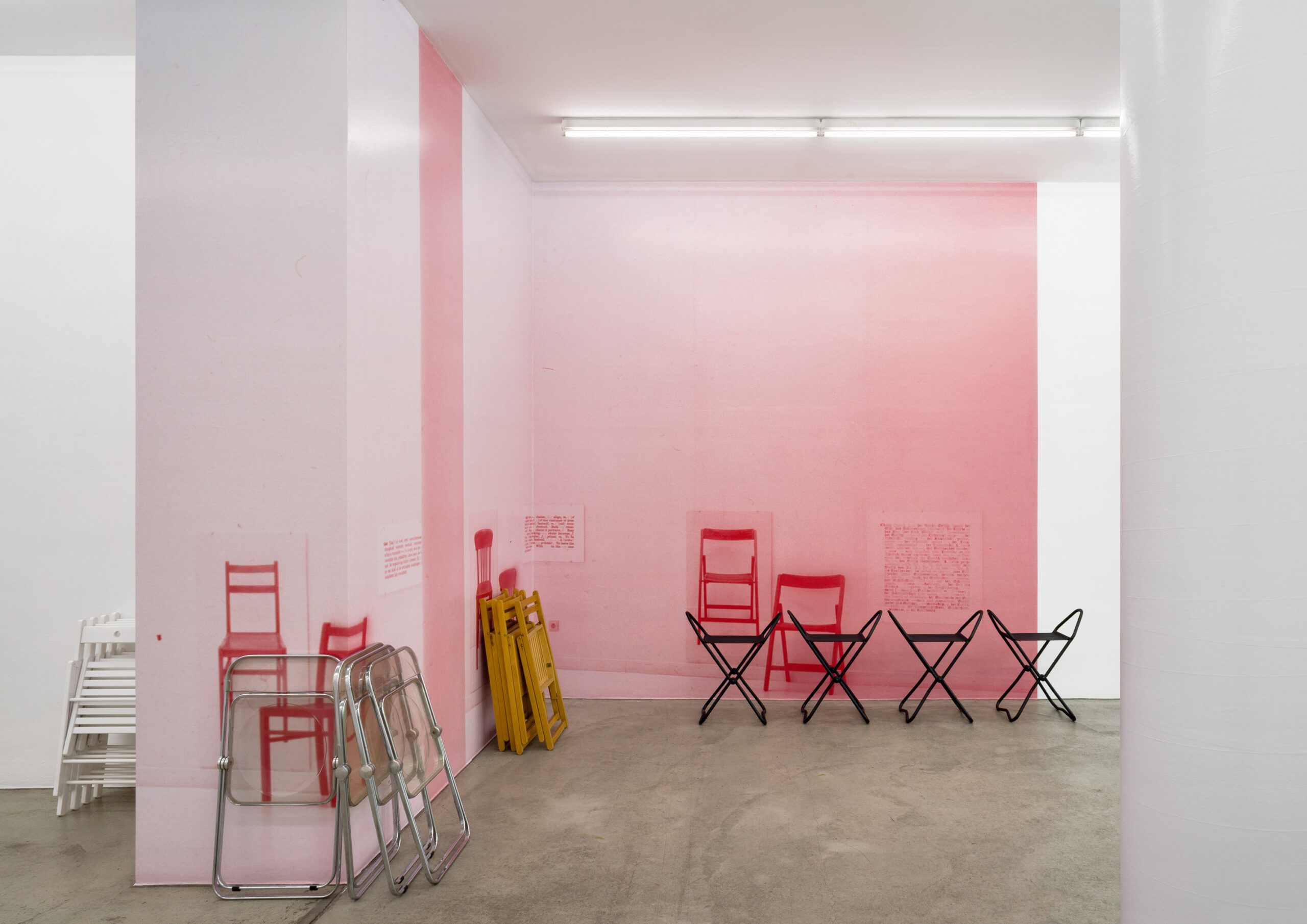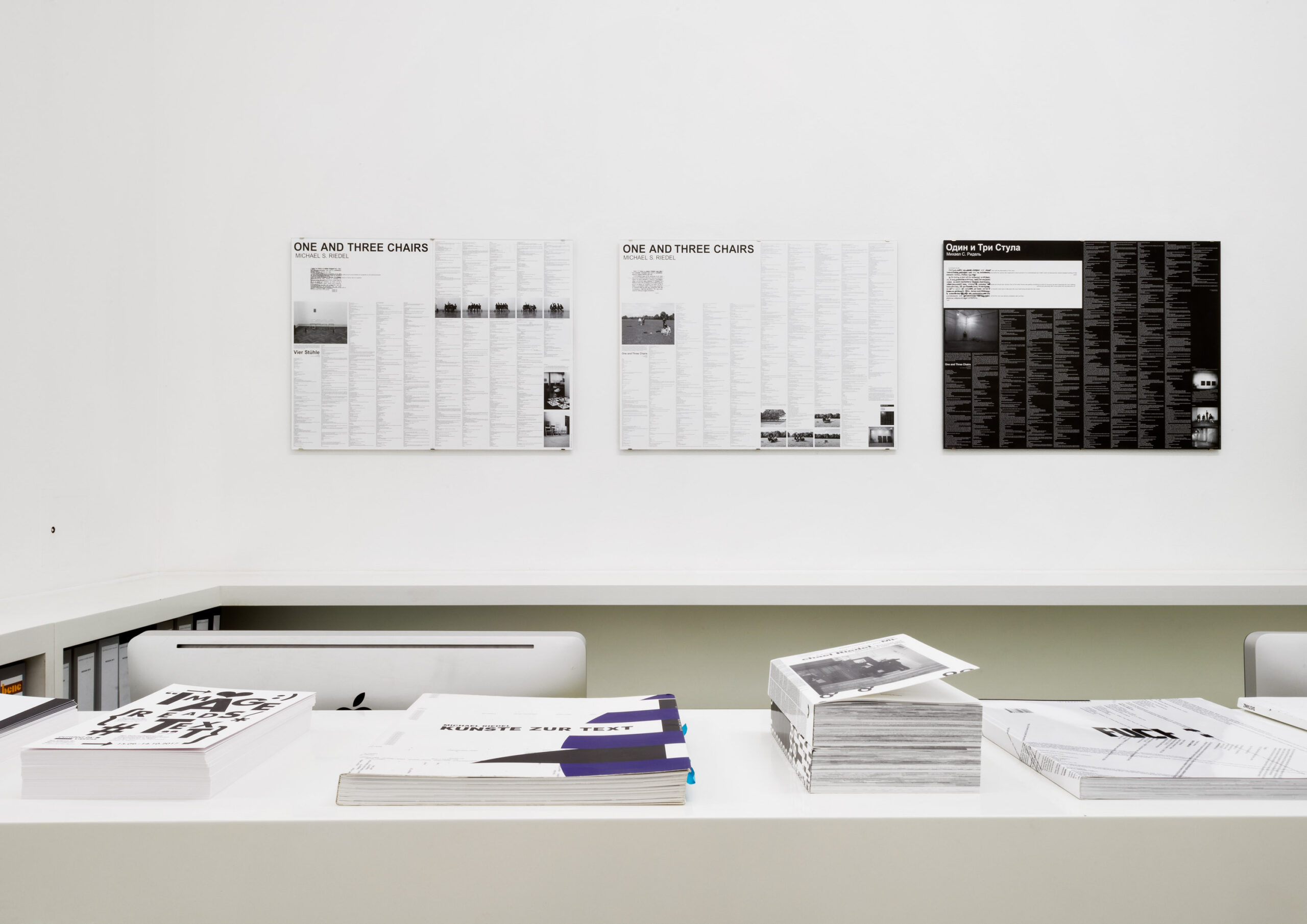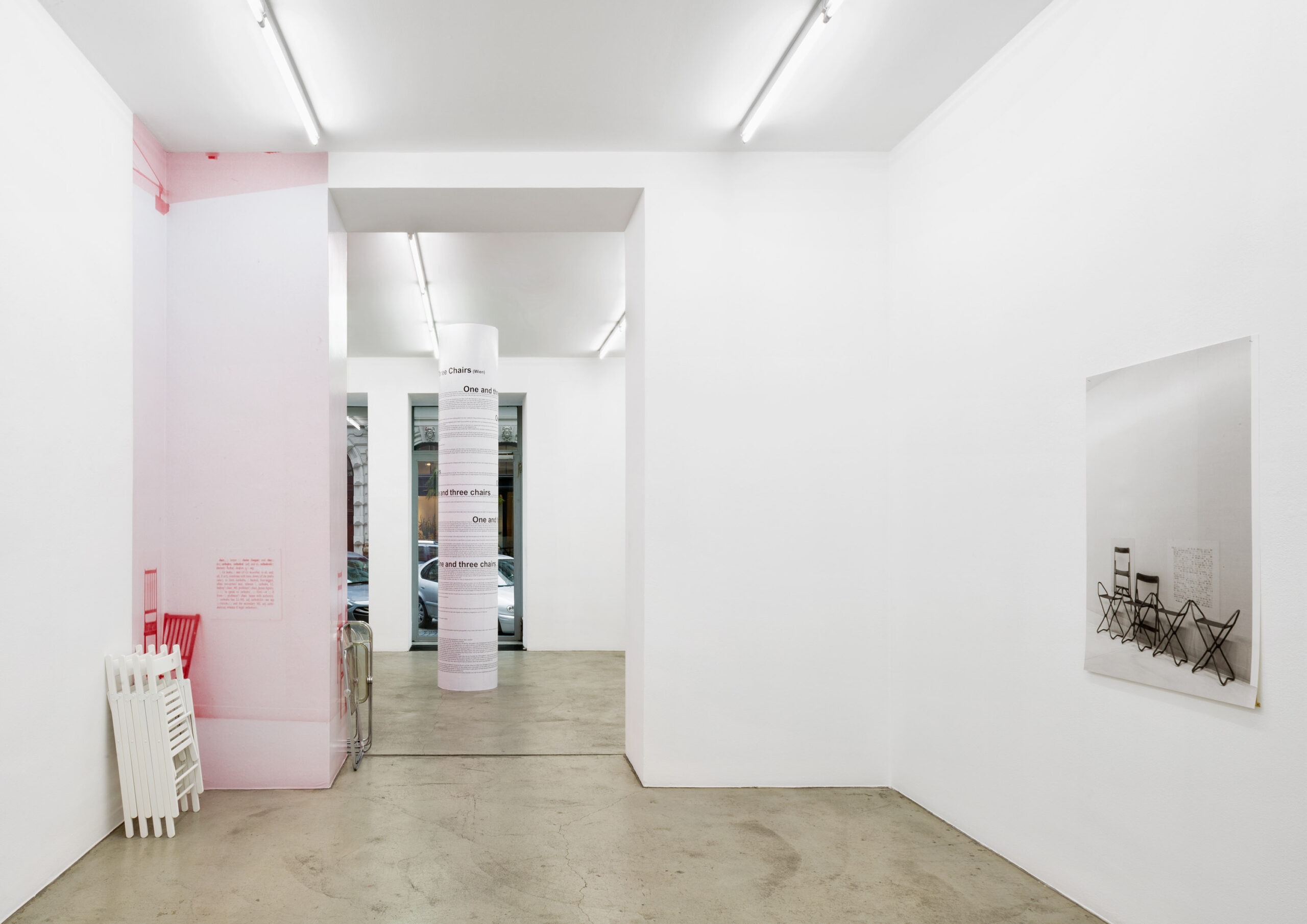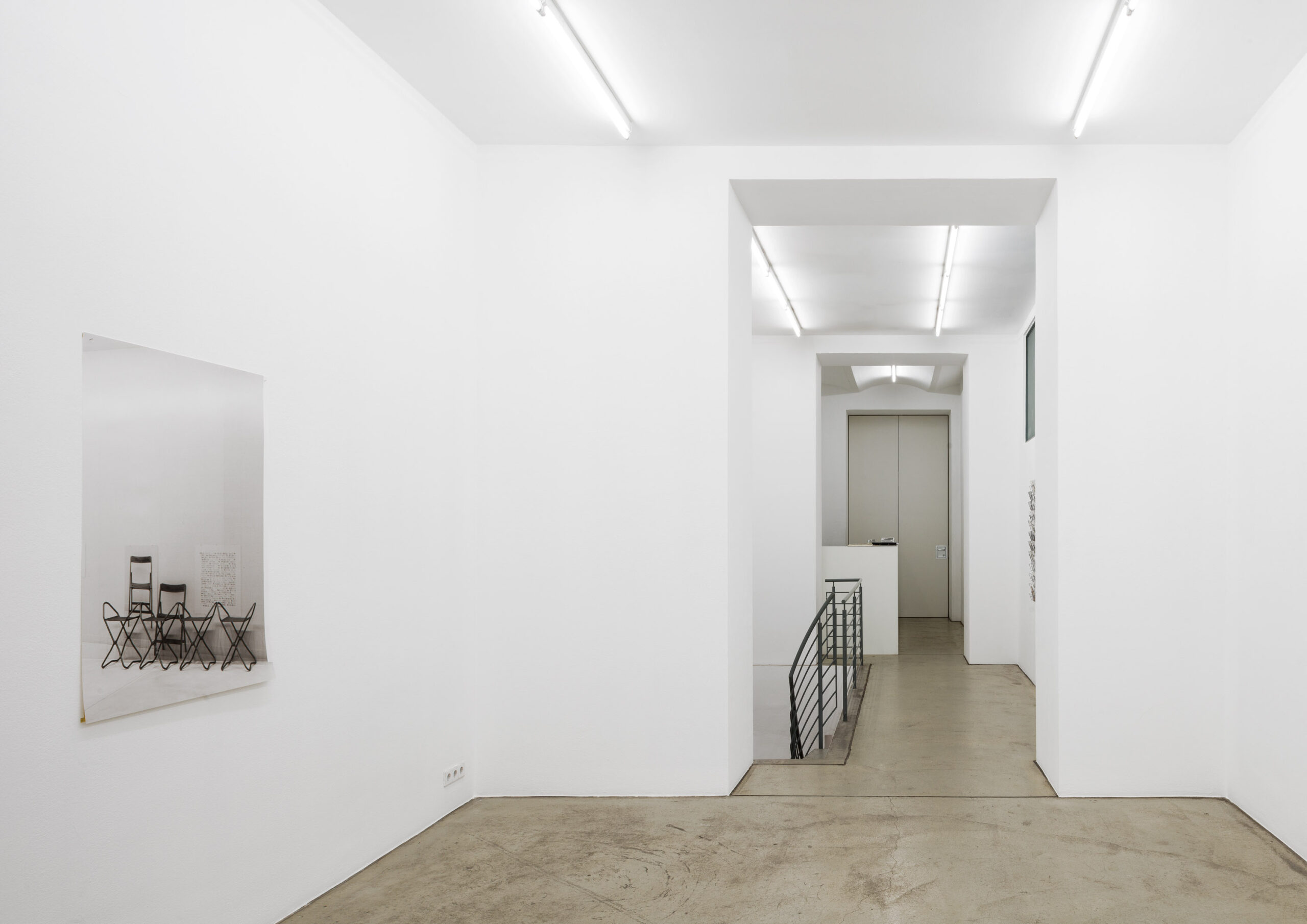
Michael Riedel
One and three chairs (Wien), 2017
Installation: Tapete, Stühle, Säule,
One and three chairs (London, Bern, Moskau), 2005/2006
Plakatserie von 3, gerahmt
Maße variabel
IMAGE/READS/TEXT – curated by Sabine Schaschl & Michael Riedel
One and Three Chairs (Wien)
«One and Three Chairs» von Michael Riedel nimmt Bezug auf das gängige Missverständnis, dass das berühmte gleichnamige Werk des amerikanischen Konzeptkünstlers Joseph Kosuth aus vier Stühlen bestehe. Tatsächlich setzt sich Kosuths Werk aus dem Jahr 1965 aus drei Elementen zusammen: einem Stuhl, einer fotografischen Abbildung dieses Stuhls und einem Lexikoneintrag zum Begriff Stuhl. Bei jeder Präsentation dieser Installation gibt eine Handlungsanweisung vor, zunächst einen Stuhl auszuwählen, diesen anschliessend vor einer Wand zu fotografieren und die Fotografie der Grösse des Stuhls entsprechend zu vergrössern. Das Foto soll dann links vom Stuhl an die Wand gehängt werden, der Lexikoneintrag rechts, wobei auf eine stimmige Platzierung zur oberen Stuhllehne zu achten ist. Kosuths konzeptueller Griff besteht dabei in erster Linie in der Auswahl der Elemente selbst, die einen Gegenstand, die Abbildung des Gegenstands und seine Beschreibung beinhaltet und so die einzelnen Erscheinungsformen und ihre Wahrnehmungs- und Bedeutungszuschreibungen hinterfragt.
Michael Riedel übernimmt zwar die einzelnen Elemente aus Kosuths Installation, ergänzt sie jedoch mit vier Stühlen, einer Performance und Texttafeln, die das bei der Performance Gesprochene festhalten. Der Präsentation in Wien sind drei Versionen vorangegangen. Die erste entstand im Rahmen der Moskau Biennale 2005 und war im Lenin Museum zu sehen. Den einzelnen Elementen von Kosuths Installation fügte Riedl hier vier Stühle und drei Texttafeln hinzu, die eine Beschreibung des Museumsraumes enthielten. Ein Jahr darauf entstand im Rahmen der Ausstellung «The Complex of Respect» eine Installation in der Kunsthalle Bern, wo nebst den Elementen aus Kosuths Installation wiederum vier Stühle und eine grosse Texttafel mit einer entsprechenden Raumbeschreibung präsentiert wurden. Im Regent’s Park in London 2006 erfuhr das Werk Riedels eine erste grössere Verschiebung: Anstelle der Fotografie eines Stuhls und des Lexikoneintrags präsentierte er lediglich vier Stühle – und zwar dort, wo vier Wochen später das Messezelt der Frieze Art Fair aufgebaut wurde. Das entstandene Foto zeigt vier auf diesen Stühlen sitzende Männer. Riedels vierte Version seiner «One and Three Chairs»-Aufführungen nimmt schliesslich einen Tourneecharakter an, der, ebenso wie Kosuths Konzept, eine immer wieder neue Aufführung zulässt. Ausgangspunkt ist ein Foto aus Kosuths Studio, das vier unterschiedliche Ausführungen seiner «One and Three Chairs»-Werke zeigt. Riedel nutzt diese Vorlage, um ebenfalls vier Versionen seiner gleichnamigen Werkreihe zu versammeln. Retrospektiv platziert er die Stühle aus Moskau, Bern und London sowie ein dazugehöriges Poster mit dem jeweiligen Beschreibungstext vor der Fototapete. Hinzu kommen vier Stühle, auf denen eingeladene Akteure Platz nehmen und, sich selbst als Teil der Installation begreifend, über das Werk sprechen sollen. Das Gespräch wird aufgezeichnet, transkribiert und als Texttafel Teil der Installation für die restliche Ausstellungsdauer.
Das Projekt «One and Three Chairs (Wien)» von Michael Riedel entsteht in Zusammenarbeit mit Barbara Rüdiger, Sabine Schaschl, Vitus H. Weh und Luisa Ziaja und wird von Michael Riedel und Sabine Schaschl kuratiert.

Michael Riedel
One and three chairs (London, Bern, Moskau), 2005/2006
Plakat, gerahmt
Auflage von 25
Je 59,5 x 84,1 cm
One and Three Chairs by Michael Riedel refers to the common misconception that the famous work of the same name by the American concept artist Joseph Kosuth consists of four chairs. In reality Kosuth’s work from 1965 has just three elements: a chair, a photographic representation of that chair and a dictionary definition of the word ‘chair’. Every presentation of the installation comes with instructions: first choose a chair, then take a picture of it in front of a wall and enlarge this photograph to the size of the chair itself. The photograph should then be hung on the wall to the left of the chair, the dictionary definition to the right at the same height as the back of the physical chair. Kosuth’s conceptual take principally comprises choosing the elements that make up the object, the representation of the object and its description, and therefore questions their individual appearances and ascribed perception and meanings.
Although Michael Riedel adopts the individual elements from Kosuth’s installation, he also adds four chairs, a performance and a panel of text recording the words spoken during the performance. There were three previous versions prior to the work’s presentation in Vienna. The first was displayed in the Lenin Museum during the Moscow Biennale in 2005. To Kosuth’s individual elements Riedel added four chairs and three panels of text containing a description of the museum space. One year later, an installation was created for the exhibition ‘The Complex of Respect’ at the Kunsthalle Bern, where alongside the elements from Kosuth’s installation once again four chairs and a large panel of text with a corresponding description of the space were displayed. In Regent’s Park, London, in 2006 Riedel’s work experienced its first major shift: instead of a photograph of a chair and a dictionary definition, he only presented four chairs – in the exact same place where four weeks later the marquee for the Frieze Art Fair would be built. The photograph taken shows four men sitting on these chairs. Riedel’s fourth version of the One and Three Chairs performance finally starts to take on a travelling aspect which, much like Kosuth’s concept, consistently allows for a range of new performances. The point of departure is a photograph from Kosuth’s studio showing four different versions of his One and Three Chairs works. Riedel uses this template to bring together four versions of his own work series of the same name. Retrospectively he places the chairs from Moscow, Bern and London as well as a related poster with the corresponding description in front of the photographic wallpaper. Added to this are four chairs on which invited actors take a seat and, perceiving themselves as part of the installation, are then expected to talk about the work. Their conversation is recorded, transcribed and made into a panel of text, which then becomes part of the installation for the remainder of the exhibition.
The project One and Three Chairs (Vienna) by Michael Riedel is created in collaboration with Barbara Rüdiger, Sabine Schaschl, Vitus H. Weh and Luisa Ziaja and is curated by Michael Riedel and Sabine Schaschl.






